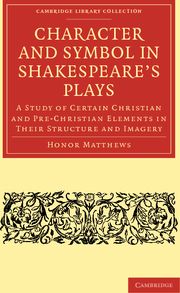 Character and Symbol in Shakespeare's Plays
Character and Symbol in Shakespeare's Plays Book contents
Chapter III - The Parliament of Heaven
Published online by Cambridge University Press: 07 September 2010
Summary
SOME PRE-SHAKESPEAREAN STATEMENTS
Under the Luciferian sin Shakespeare subsumes man's many acts of rebellion against his God. Once the validity of an absolute command has been admitted and the command broken, an obsessional sense of guilt becomes inevitable. Hence the persistent concern of medieval art and literature with the judgment of God in its double aspect of the justice deserved and the mercy so urgently needed. This concern can be well illustrated by the popularity of the debate between the four virtues who came to be known as the Daughters of God. They are named in Psalm lxxxv, verse 10, ‘Mercy and Truth are met together; Righteousness and Peace have kissed each other.’ The tradition of dramatising the conflict between Justice and Mercy as a debate or trial is very ancient, going back at least to the action between the Erinyes and Apollo for the life of Orestes in the Oresteia, and the use of legal imagery by Shakespeare in this connection is one of the clearest examples of the influence of medieval patterns on his imagination.
The symbol of a debate between the Daughters concerning the fate of mankind spread rapidly over Europe where it appears in the literatures of France, Italy, Provence, Germany, Holland, Hungary and Spain as well as of England. It occurs first in the eleventh century in a version of the rabbinical Midrash. The first important Christian application of the allegory is made by St Bernard of Clairvaux (1091–1153) in a sermon, In Festo Annunciationis Beatae Virginis, and the earliest known English mention of the Daughters is in the dialogue Vices and Virtues (c. 1200).
- Type
- Chapter
- Information
- Character and Symbol in Shakespeare's PlaysA Study of Certain Christian and Pre-Christian Elements in Their Structure and Imagery, pp. 71 - 118Publisher: Cambridge University PressPrint publication year: 2009First published in: 1962
